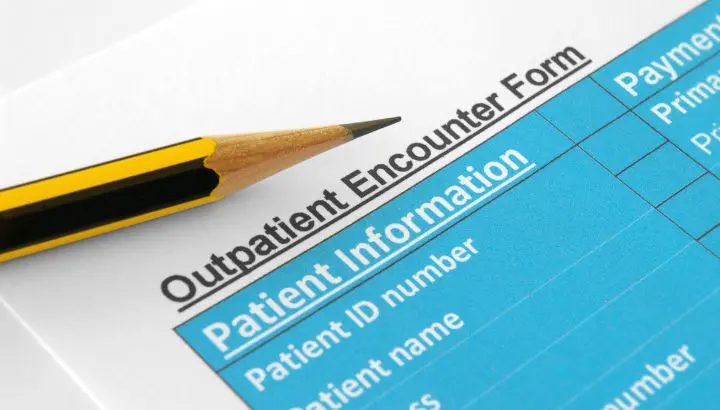

Doctors work an average of 51 hours a week and see 20 patients daily. This means hospitals and healthcare organizations need an efficient system to track patients accurately. One of the ways to do this is by having an encounter form.
Let’s take a closer look at what an encounter form is and the advantages it offers in a healthcare setting.
Table of Contents

An encounter form is used to document each interaction between a patient and a health service provider. Specifically, a medical encounter form determines how much a healthcare organization would earn. Encounter forms are also called superbills since they are used as a basis for billing, reimbursement, and receipts for payments.
An encounter form also documents the services rendered and lists the diagnoses, procedures, and medications associated with those services. The form can also include information about demographics and insurance coverage.
In the United States, patients are charged for each service and medication received during a consultation, instead of getting charged for the overall treatment. Encounter forms help track these charges so there would be an accurate billing statement.
Encounter forms must include:
Additionally, it records patients’ reactions to medicines and possible recurring symptoms. Depending on the patient’s condition, you may add more fields aside from basic information.
An example would be when someone gets admitted for pneumonia. When this happens, the encounter form would show the patient’s hourly temperatures, drugs administered, and the signature of the attending physician.
Encounter forms serve as the foundation of a good medical billing system. They represent a detailed account of the encounter between a patient and provider.
This information is essential for billing purposes, allowing admin staff to:
By maintaining accurate and up-to-date encounter forms, practitioners and professionals ensure that their patients are billed correctly.
Encounter forms are essential in healthcare because it determines the amount you have to pay after hospital charges and insurance adjustments.

The truth is the healthcare setting is inherently busy. Some healthcare providers work 12-hour shifts or more. That’s why using digital encounter forms is convenient, allowing hospital staff to have more time for patient care.
Here are the perks of digitizing encounter forms:
Doctors, nurses, and other healthcare service providers must write down details on dozens of encounter forms daily. They also need to affix their signature to each document, which can mean signing hundreds of pages in a shift. Now imagine using pen and paper to do this.
Electronic signature software has smart filling features, so you won’t have to sign or add your signature on every form you fill out. Simply click on the suggested options and use your esignature to save time.
If medical billing is inaccurate, it can affect a hospital’s reputation and place staff jobs at risk. Incorrect billing can also reduce a hospital’s income, affecting employees’ compensation. They may then choose to leave for other opportunities.
Encounter forms are necessary because they help track a healthcare organization’s cash flow. It can also help reduce the risk of insurance fraud. By requiring patients to provide detailed information about their symptoms and treatment, encounter forms help ensure that legitimate claims are filed.
Patients interact with a lot of people in a hospital setting, including nurses, resident doctors, to name a few. With digital encounter forms, medical staff can improve their workflow by easily filing and retrieving patient data using an electronic health record system (EHR).
Software that supports digital encounter forms can be integrated with EHR systems. Medical staff will find it easier to collect, find, and share patient data with a unified system. Moreover, patients can fill out online forms in minutes rather than passing printed documents from one practitioner to another.
Healthcare organizations frequently have storage rooms full of paper files. Not only do these printed forms consume a lot of storage space, but they are also not environmentally friendly. They can be time-consuming to file and retrieve, and they are often misplaced. Even worse, outdated or illegible paper records can lead to errors in care.
It’s a good thing then that digital forms are stored in the cloud. You no longer need to deal with stacks of paper files or the inconvenience of printing patient charts. In case there’s computer or system malfunction, the data is still available online. When patients request copies of their records to file insurance claims, hospital staff can easily provide them.
Plus, practitioners can access forms using their computers and smartphones while doing patient rounds.
The Primary Care Encounter Form is a document used by healthcare providers to document a patient’s visit. It includes information such as the patient’s medical history, current health concerns, and any treatments or medications prescribed. It also includes the provider’s assessment and any follow-up instructions given to the patient. The form is typically completed at the end of the visit and serves as a record of the visit for the patient and provider.
The Emergency Department Encounter Form is an essential tool for medical professionals when treating patients in emergency situations. It helps to ensure that the patient receives the best care possible, while also providing a record of the encounter for future reference. This form is designed to provide a comprehensive overview of the patient’s condition and the treatment they receive. Additionally, it can be used to track the patient’s progress over time, allowing medical professionals to monitor their recovery and provide the necessary follow-up care.
The Outpatient Encounter Form is an invaluable tool for healthcare providers to ensure that patient visits are documented accurately and efficiently. It is also an important part of the patient-provider relationship, as it allows for a more comprehensive understanding of the patient’s medical history, symptoms, and treatments. Additionally, the form can be used to track the progress of a patient’s treatment plan over time, providing a valuable resource for both the patient and the provider.
Encounter forms are also referred to as encounter slips, routing slips, or superbills. It is a document used to record medical encounters between patients and healthcare providers. An encounter form often comes with a care slip, which physicians use to note essential details about patient appointments.
Yes, encounter forms can be completed online. Physicians can use electronic signatures to sign off on digital forms. It’s recommended to use a HIPAA-complaint platform when migrating to digital forms.
If an encounter form is not completed correctly, it may need to be resubmitted or corrected. In some cases, this can lead to a denied insurance claim or delays in payment. You must take extra care when completing an encounter form so that it contains accurate and relevant information.
Encounter forms make it possible to give accurate billing statements to patients. They also speed up financial processes and insurance claims.
With Fill, you don’t have to create forms from scratch. Choose from a large library of form templates that you may tailor to fit your needs. Online encounter forms can be signed digitally by doctors and medical staff on any device.
There’s no need to print out physical forms. This process also reduces human error in encoding patient data because the clients themselves fill out the forms. If that’s not enough, Fill also supports API integration so you can include document signing and data collection in your EHR system.
Are you ready to make the switch to digital forms? Sign up for an account and save time in gathering accurate data with Fill today.